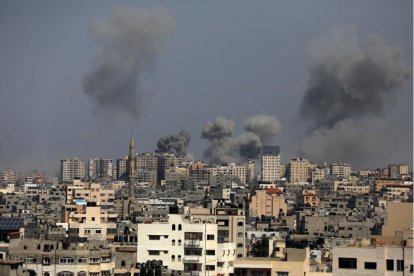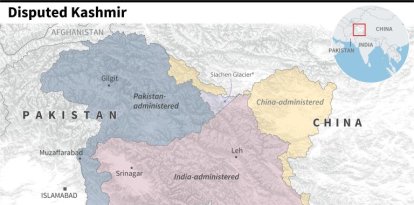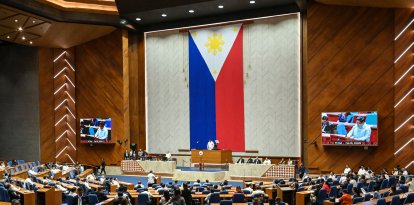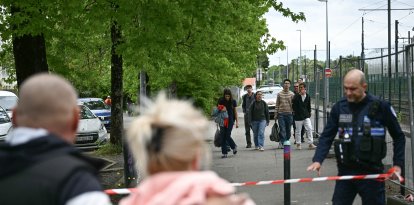A month of war: From the Hamas terrorist attacks to Israel's incursion in Gaza
Israeli forces have advanced their ground operation in Gaza and neutralized more than 450 Hamas targets. They also managed to take control of an enemy military complex and disable several tunnels.

(Cordon Press)
"At 6:29, one month ago, 1,400+ Israeli civilians were massacred by Hamas terrorists". Since then, Israel has been fighting against the barbarity of the Hamas terrorist group. These have been days in which the Israeli authorities have exposed the worst side of the terrorists. From kidnapped citizens to murdered children and raped women, the criminals have been exposed to the world for their utter evil. 30 days in which, alongside messages of support and solidarity, heroic actions and commitment to the horror suffered by Jewish civilians, anti-Semitism has reemerged with virulence around the world, with murders, threats and demonstrations that reinforce the terrorists' stance.
Israel, "at war"
It all began on Oct. 7 when Hamas murdered at least 1,400 people in one of the largest attacks ever recorded in Israel's history. It was at that time that Prime Minister Benjamin Netanyahu announced that the country was at war and announced the start of Operation Iron Swords.
This was no coincidence. On Oct. 8, just 24 hours after Hamas carried out the attack, a senior official from the terrorist group revealed in an interview with Russia Today TV that they orchestrated the invasion onto Israeli soil, circumventing Western intelligence services. “We have been preparing for this for two years. We have local factories for everything. We have rockets with ranges of 250 kms, 160 kms, 80 kms, 45 kms, and 10 kms,” said Ali Baraka, Hamas' head of national relations abroad, according to a transcribed translation from the Middle East Media Research Institute. On this day, Hezbollah began to bombard Israeli territory with rockets, provoking the response of the IDF and the fear of an open war on two fronts.
On Oct. 9, the European Commission, one of the seven high institutions that make up the European Union (EU), announced that it would urgently review its aid payments to Palestine following the attacks carried out by the terrorist group against Israel. Although it was initially reported that all money flow would be stopped immediately, the commission clarified in a statement that it would assess "as soon as possible" whether EU assistance to Palestine benefits terrorist organizations, even "indirectly."
Meanwhile, in its initial self-defense operations, on Oct. 10, Israeli authorities reported that they had killed Zachariah Abu Ma'amar, head of the International Relations Office of Hamas's political bureau. He was killed when an Israeli plane attacked him.
"During the night, an IDF plane hit Zachariah Abu Ma'amar, a senior member of the political bureau of the terrorist organization Hamas," Israeli authorities wrote on X (formerly Twitter). The terrorist was responsible for Hamas' internal communications and coordination between terrorist organizations in the Gaza Strip. He was known for his proximity to Hamas' leader in Gaza, Yahya Sinwar.
That same day, it was learned that Joad Abu Shmalah was also neutralized. He was Hamas' economy minister in the Gaza Strip and, according to the authorities, was the financial arm of the terrorist group.
On Oct. 10, the international press also entered several kibbutzim and was able to see the atrocities that terrorists committed against Israeli citizens. For example, i24NEWS correspondent Nicole Zedek broke down in tears that day while reporting that Hamas murdered at least 40 babies in the Kfar Aza kibbutz, where they also killed dozens of others in their homes.
Emergency unified Goverment
On Oct. 11, Israeli Prime Minister Benjamin Netanyahu and opposition leader Benny Gantz reached an agreement to form an emergency unified government to enhance security in the country after the brutal terrorist attack on Saturday that led to the start of the war against Hamas.
Meanwhile, on Oct. 12, U.S. Secretary of State Antony Blinken held a meeting with Israeli Prime Minister Benjamin Netanyahu in Tel Aviv to convey U.S. support for Israel in the conflict. After the meeting, both offered a press appearance.
That same day, the Israeli Air Force published a video showing the attack in which Muhammad Abu Shamla, a senior Hamas naval operative in the Rafah Brigade, was killed. Abu Shamla was an agent of Hamas' Nukhba forces and his residence was used to store naval weapons intended to carry out attacks against the Israelis.
Another of those responsible for the Oct. 7 massacre and commander of Hamas' Nukhba Jabalya Assault Company, Ali Qadi, was killed on Oct. 14. "Hamas’ Nukhba forces led the brutal massacre of Israeli civilians in communities surrounding the Gaza Strip on October 7th. Furthermore, in 2005, Qadi was apprehended after the kidnapping and murder of Israeli civilians and was released as part of the Gilad Shalit prisoner exchange," the IDF indicated.
Between Oct. 15 and 16, it was learned that Belal Alqadra, commander of the Nukhba Southern Khan Yunis Company, had been eliminated. He was behind the murder of families and children in several kibbutzim. "Alqadra himself was largely responsible for the massacre of innocent Israeli women, children and men at Kibbutz Nirim and Nir Oz on October 7," officials said.
The National Center for Forensic Medicine of Israel, Abu Kabir, allowed on Oct. 17, for the first time in its history, the foreign press to enter its facilities with the aim of disclosing the atrocities committed by Hamas. That day, U.S. Department of Defense officials also confirmed the dispatch of more than 2,000 Marines and naval forces to the Israeli coast.
Biden visits Israel
President Biden was welcomed on Oct. 18 by Benjamin Netanyahu. The arrival of the American president occurred amid a wave of violent protests throughout the Arab world and the call by Hezbollah for "a day of unprecedented rage" after the impact of a projectile fired by Hamas terrorists on the Al-Ahli Hospital in Gaza that caused numerous deaths. Hamas, with the invaluable help of most of the major Western media, which bought the terrorists' information without checking it, accused the Israeli air force of the attack and put the death toll at more than 500. However, subsequent investigations showed that it was the wreckage of a Palestinian-launched rocket that hit the parking lot of the health center. The actual number of casualties was between 10-50, according to these reports.
On Oct. 19, Jamila al Shanti was killed: the first woman elected to the Hamas political bureau and widow of the group's co-founder Abdel Aziz Rantisi.
On Oct. 21, the Rafah border crossing, located in the southern Gaza Strip, opened for the first time since Oct. 7. At least 20 trucks carrying humanitarian aid were able to access through this pass located on the border with Egypt. The next day, the Israeli army reported that the number of hostages being held in Gaza by Hamas .
On Oct. 23, faced with claims by some groups that information being published by the Israeli authorities was false, they decided provide several journalists with access to images from body cameras worn by Hamas terrorists during the massacre Oct. 7, which they described as "horrifying" and "never seen." Israel provided the media with this access to counter a "phenomenon similar to Holocaust denial," as announced by Israeli authorities
Israel charges against "biased" UN
On Oct. 24, the Israeli foreign minister addressed the atrocities committed by Hamas before the United Nations (UN). In addition, Israel called for the resignation of Antonio Guterres as UN secretary general, considering that his position in the conflict is biased.
"As we meet here today, young babies, children, are held in Gaza, this is beyond imagination, living a nightmare," Eli Cohen told the UN Security Council.
That night, the Israeli Defense forces attacked more than 400 targets. As reported by an army spokesmen, during night operations, air forces managed to kill three Hamas leaders and disable vital infrastructure for terrorists, such as weapons, facilities and even a tunnel that allowed them to quickly and safely access the coast and infiltrate Israeli territory.
On Oct. 25, the Israeli Defense Forces claimed to know the identity of the spokesman for the Al Qassam Brigades, Abu Obaida. According to the Israeli military, Obaida's true name is Hudhayfah Kahlot. Along with this name, the IDF also provided a face. They also killed another Hamas commander in their offensive against the terrorists.
The Israel Defense Forces (IDF) carried out a ground operation in the Gaza Strip on Oct. 26. According to the IDF, this was a preparation for the next phase of the combat and a ground incursion into Gaza.
Another important moment during this Israeli struggle was on Oct. 28, when the majority of members of the United Nations voted in favor of an Arab-drafted resolution which makes no specific mention of the terrorist group that massacred more than 1,400 Israelis, but asks the Jewish state to cease "hostilities" in Gaza.
Hezbollah threats U.S.
Meanwhile, Sayyed Hassan Nasrallah, leader of the terrorist organization Hezbollah, gave a speech on Nov. 3 in which he threatened the United States for what he calls "crimes perpetrated by Israel in Gaza," for which he believes that "it must pay price." Furthermore, he applauded the massacre carried out by Hamas on Oct. 7. In a televised message, Nasrallah acknowledged that, despite not having been previously informed of the attack, Hezbollah joined the fight the next day with the launching of rockets against Israeli territory.
The following days, Nov. 5 and 6, Israel advanced its ground operation in Gaza and neutralized more than 450 Hamas targets. It also managed to take control of an enemy military complex and claimed that several tunnels had been disabled.
Israel's operations to defend itself continue while the barbarity and violence of the terrorists is becoming increasingly evident to the world, all while citizens remain hopeful that those kidnapped by Hamas will return home. This Monday, Nov. 6, photos of the hostages were put on the walls of Jerusalem to call for their release. "May our prayers from Jerusalem reach them in Gaza," wrote the State of Israel.
RECOMMENDATION





















